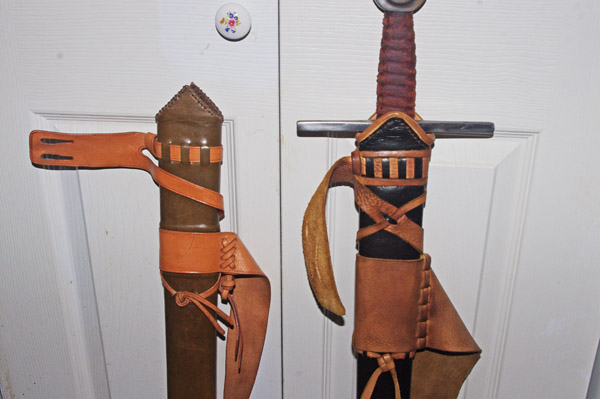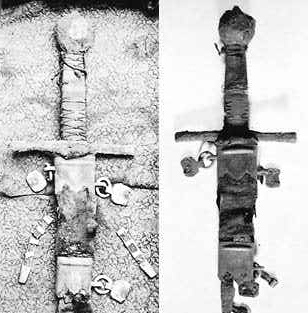| Author |
Message |
|
Jeremy V. Krause
|
 Posted: Wed 04 Dec, 2019 6:50 am Post subject: 12th. C. scabbard fittings Posted: Wed 04 Dec, 2019 6:50 am Post subject: 12th. C. scabbard fittings |
 |
|
Hello everyone,
Some of you may know that I am having a 12th. C sword completed. It's a reproduction of the SobÝrg sword (1125-1175 C.E.)
Well now it's time for the scabbard. I have seen the relatively simple chapes reproduced on swords of this time period. I may have seen a few buckles compared to the "split-tongue". ends we often see.
Do folks have images of 12th. C. chapes and maybe buckles? Do folks think that a buckle could even be appropriate for a 12th. C. scabbard- even of a high status weapon or later 12th. C. example?
Lastly, and this is a stretch- does anyone know of scabbard fittings from the period featuring inlay as this would look especially nice I think, if it could be justified.
Thanks for your help!
|
|
  |
 |
Harry Marinakis

|
 Posted: Wed 04 Dec, 2019 9:03 am Post subject: Posted: Wed 04 Dec, 2019 9:03 am Post subject: |
 |
|
A lot depends on geographics.
In the German Empire, the "split tongue" leather-only belts persisted, almost exclusively, well into the 13th and 14th centuries. The British transitioned to belt buckles in the late 12th century. You can search the illuminated manuscripts for examples of various buckles that were used at the time.
The suspension of the scabbard also varies quite a bit. Vertical scabbard suspensions were the norm early on, and were present throughout the medieval period, especially in the lower ranks. The offset belt suspension seems to have been invented in the German Empire sometime around AD 1200 (give or take). Upper ranks seemed to use metal lockers and rings for the suspension.
The scabbards of the late 1100s were all quite plain - nontooling, no fancy accoutrements. Most did not seem to have a chapes. The few chapes that are seen are quite plain.
https://myArmoury.com/talk/viewtopic.php?t=30408&highlight=
|
|
  |
 |
|
Jeremy V. Krause
|
 Posted: Wed 04 Dec, 2019 10:52 am Post subject: Posted: Wed 04 Dec, 2019 10:52 am Post subject: |
 |
|
| Harry Marinakis wrote: | A lot depends on geographics.
In the German Empire, the "split tongue" leather-only belts persisted, almost exclusively, well into the 13th and 14th centuries. The British transitioned to belt buckles in the late 12th century. You can search the illuminated manuscripts for examples of various buckles that were used at the time.
The suspension of the scabbard also varies quite a bit. Vertical scabbard suspensions were the norm early on, and were present throughout the medieval period, especially in the lower ranks. The offset belt suspension seems to have been invented in the German Empire sometime around AD 1200 (give or take). Upper ranks seemed to use metal lockers and rings for the suspension.
The scabbards of the late 1100s were all quite plain - nontooling, no fancy accoutrements. Most did not seem to have a chapes. The few chapes that are seen are quite plain.
https://myArmoury.com/talk/viewtopic.php?t=30408&highlight= |
Thanks Harry,
I read through the link and am interested in the question of vertical and off-set suspension. I really prefer the look and practicality of an off-set suspension. Is the off-set suspension the one we typically see on reproductions? So this could be appropriate (albeit more rare) for the late 12th. C.?
What do you mean by metal "lockers and rings?" Is there a depiction of this?
It does look like the split-tongue tie is the more appropriate option with a simple chape. The sword is found in Denmark. What regional influence would a scabbard from this area be subject to?
|
|
  |
 |
Harry Marinakis

|
 Posted: Wed 04 Dec, 2019 3:55 pm Post subject: Posted: Wed 04 Dec, 2019 3:55 pm Post subject: |
 |
|
The offset sword belt is one of the typical but inappropriate suspensions found on modern reproductions of early swords.
Denmark? I did a quick search and couldn't find any specifics. I would guess Denmark would be most influenced by Scandinavian trends.
I have not found any evidence of offset belts before AD 1200.
If you notice, the split belts are so soft that they look like fabric when knotted. To get the proper look, you've got to use a very soft leather that doesn't stretch. I use a very soft Latigo. Most veg tan leathers are just too stiff. One photo below shows the difference between a stiff veg tan leather and and soft Latigo. Both are offset sword belts. The soft Latigo hangs correctly and has the proper "look."
The other photo shows locket and rings.
 Attachment: 71.37 KB Attachment: 71.37 KB

 Attachment: 92.67 KB Attachment: 92.67 KB

|
|
  |
 |
Kai Lawson

|
 Posted: Wed 04 Dec, 2019 5:17 pm Post subject: Posted: Wed 04 Dec, 2019 5:17 pm Post subject: |
 |
|
That last image of the locket and rings isn't 12th century--it's from the tomb of an Italian nobleman, Cangrande I della Scala, who died in 1329. I don't claim to have Harry's expertise, but I have also been combing manuscripts, sculpture and iconography for scabbard images and suspensions. I have yet to see any ring mount suspension past 1000/1050 (in the Baltics) before, say, 1275-ish. I would also respectfully disagree with the lack of offset belt in the 12th century. I have seen some existing examples of surviving scabbard leathers with holes that would hold the scabbard at an angle, if laced in a way that is commonly depicted in period. That said, I have also seen many depictions of scabbards that show the same lacing with vertical orientation. My vote would be to pick the option that best fits the region you want. There are some murals from late 12th century Denmark (dunno what the church is called at the moment) showing some soldiers, but I don't remember if the scabbards are displayed well.
"And they crossed swords."
--William Goldman, alias S. Morgenstern
|
|
  |
 |
Harry Marinakis

|
 Posted: Wed 04 Dec, 2019 5:52 pm Post subject: Posted: Wed 04 Dec, 2019 5:52 pm Post subject: |
 |
|
Kai I would love to see your evidence of offset belts before 1200
I have spent a lot of time researching the origins of the offset belt, so this is of great historical interest to me.
And the locket/ring photo was just a sample, not meant to represent a specific date. Sorry for the lack of clarity.
|
|
  |
 |
Harry Marinakis

|
 Posted: Thu 05 Dec, 2019 6:25 am Post subject: Posted: Thu 05 Dec, 2019 6:25 am Post subject: |
 |
|
So I did a little more research on my prior research.
The very first evidence that I have of the offset sword belt is from the statues of Margrave Ekkehard II and Uta from the Naumburg Cathedral in Germany. The statues clearly depict offset scabbards with offset belts. Construction of these statues started in AD 1207, which means that planning of the cathedral likely started years before then. So we may assume that these offset belts were present at or about AD 1200.
I have not been able to find any earlier evidence of offset belts.
http://myArmoury.com/talk/viewtopic.php?t=31525&highlight=
|
|
  |
 |
|
Jeremy V. Krause
|
 Posted: Thu 05 Dec, 2019 7:03 am Post subject: Posted: Thu 05 Dec, 2019 7:03 am Post subject: |
 |
|
OK, how about a vertical orientation with a buckle? I know they would be dated later in the 12th. C. but the design of this sword would benefit from a buckle.
Really staying straight to what we have in depictions would make this piece might look a bit wonky so I'm trying to find a happy medium. I'm generally slavishly committed to accuracy but I don't want to distract from this sword which is fairly impressive.
I'm thinking of maybe a slightly later period scabbard than the sword.
Were the locket and ring sets hung vertically as well? Do we have any 12th. canterbury example of this hardware?
|
|
  |
 |
|
Jeremy V. Krause
|
 Posted: Tue 17 Dec, 2019 10:07 am Post subject: Posted: Tue 17 Dec, 2019 10:07 am Post subject: |
 |
|
So here's the deal.
This never occurred to me but here it is.
Many or even most swords of the 12th. C. were on the long side. The particular sword I am having made has a 36.5 inch blade. I am 5''9, thus this sword will hit the ground when hung vertically.
What's the deal? It's hard to think that sword length was based off of the height of the individual because most swords of the period were quite long.
Were these scabbards designed for use from horseback?
I'd kind of like to be able to wear my sword but don't see a way around this if we are saying off-set suspension is inappropriate for the period.
|
|
  |
 |
|
|

